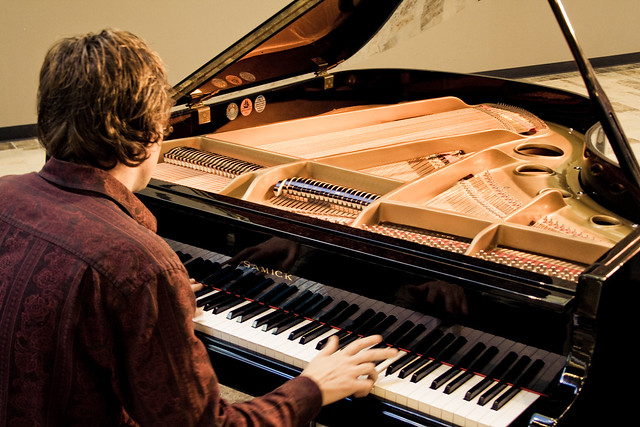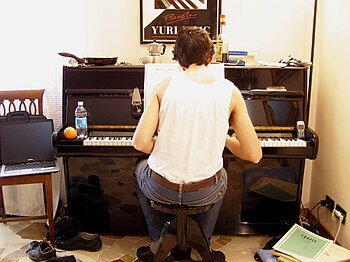 |
| Piano, keys (Photo credit: Wikipedia) |
Is it really possible to learn to play piano in a flash? That would be impossible because according to some expert pianists, it took them years to learn their lessons and play effectively. However, there is one way to improve your learning process in a flash.
You might be wondering how, right? Well, it is really simple. You have to take note of your posture. This is very important when playing the piano. Try to observe pianists; they have great postures and they seem to play with ease at all times. Without proper posture, you will not learn the basic playing techniques and even if you do, you can’t play the instrument comfortably.
Some say that it is easier to teach children when it comes to posture but even if you’re an adult, you can still improve your posture. If you can do this, you can play comfortably and with flexibility.
1. Try to imagine yourself sitting and you’re about to play the piano. See yourself as a giraffe; feeling as if your neck and head can reach the ceiling.
2. The next thing that you have to do is to stretch your arms. Try to imagine that the arms are the wings of an angel. Stretch your arms to the sides until your elbows are horizontally pointed.
3. Now, focus your attention to your hands. Look at your fingers. Move them just like the legs of a spider. Walk each of your fingers to the piano keys.
4. You have to sit on the bench with ease and confidence. Try to think that you’re the best pianist there is and that you know all your pieces well.
5. When sitting on the bench, your elbows should be located right in front of the stomach. Stretch your arms until your fingers touch the piano keys. Never scoot forward. Sit as if you’re glued to the bench.
2. The next thing that you have to do is to stretch your arms. Try to imagine that the arms are the wings of an angel. Stretch your arms to the sides until your elbows are horizontally pointed.
3. Now, focus your attention to your hands. Look at your fingers. Move them just like the legs of a spider. Walk each of your fingers to the piano keys.
4. You have to sit on the bench with ease and confidence. Try to think that you’re the best pianist there is and that you know all your pieces well.
5. When sitting on the bench, your elbows should be located right in front of the stomach. Stretch your arms until your fingers touch the piano keys. Never scoot forward. Sit as if you’re glued to the bench.
Did you notice anything on the five posture pointers mentioned? Which word is used many times? The word ‘imagine’ is used most of the time. This is very effective especially if you’re still a child but it can also work for adults. Try using your imagination. This way, your body and mind will connect instantly and you can play naturally.
The next time you practice on your piano, try to follow these pointers. Follow them one by one until you finally learn. These pointers are truly effective if you can follow properly. Even your piano teacher or instruction manuals will say the same thing. Here’s a question for you – have you ever seen a pianist who slouches? That would be quite funny and irritating, right?
Start by learning to have a good posture. This is one of the starting points to learn to play the piano in a flash. But all the other lessons should be taken one step at a time. You have to retain all the lessons. That is why you have to review your past lessons often to make sure that you still know them. You can’t simply forget past lessons because you will need them in the future lessons that you’re going to have.
The truth is, you can’t play piano in a flash. But with a little improvement in terms of your posture, you can go a long way. Take note of your posture now and check if you have a good one.



